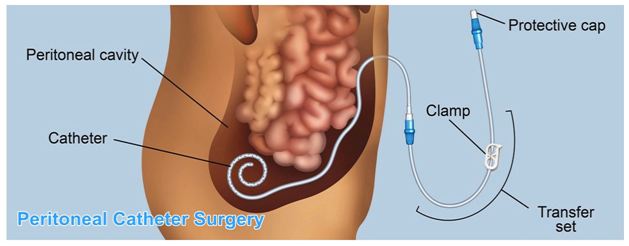PD Catheter Placement – What to Expect?

The peritoneal dialysis is easy and often done by people to take charge of ownership for their condition of kidney failure. Catheter plays a very crucial role in the process of peritoneal dialysis often people are most alarmed about it.
If you are looking for peritoneal catheter placement in Texas, you can come to the Southlake General Surgery, by making an appointment you can come to us and consult about your medical condition. For now, you can go through this article for detail information.
Surgical
PD catheters are placed by peritoneal catheter surgery. Surgery requires a patient to be given light anesthesia. With the help of a scalpel, the surgeon will cut open skin and muscle, then 1-2 inch tiny cut through peritoneum will be made. Some omentum (a curtain of tissue inside the abdomen) may need to be taken out to clear the way. A catheter is placed and is pushed through this cut and then stitched, then the exit site will be closed. To make a place for the catheter under the skin tunneling tool is used.
Know Your Catheter
The peritoneal dialysis catheters are soft and flexible, made up of polyurethane or silicone and have one or two Dacron cuffs. One cuff is placed under the belly and the second cuff may be placed in the skin at the exit site. The other important function of the cuff is to avoid the germs entering the catheter. You can come to Southlake General Surgery where our surgeon Dr. Valeria Simone MD can help you more to understand by pictures of after surgery of how a peritoneal catheter surgery takes place.
Abdominal PD Catheters
Catheters are commonly placed in the belly. Since it is on the belly you need to tell the doctor where your belt falls to avoid any rubbing after the catheter is placed. Typically, catheters are placed an inch right or left of your belly button.
Presternal Catheter
It is placed on the chest wall due to some reasons the tip, however, reaches down the belly. The main reason to place a catheter in the chest is that it has a thinner skin as compared to belly and also fewer chances of germ entry to reduce any chance of possible infection.
How You May Feel Afterward
In our experience, the patient who has come for peritoneal catheter placement in Texas had no or less pain post-surgery, in many cases patient do not require any kind of pain killers. But the pain mostly depends on the person as for few patients it is noticed that pain remains for 3-5 days, making simple activity like wearing pants can be very hard.
The thing to be concerned about
There are many things that you need to be concerned about post-surgery as some challenges are ranging from following a healthy hygiene habit and other techniques. The issues are as follows-
Hand Washing
Germs are all over and you need to follow aseptic techniques post-surgery to avoid any kind of infection. Infection those are common:
- Exit site injection tunnel infection
- Peritonitis
Other problems that are not infections can also occur with a PD catheter:
- Migration
- Problems draining
- Hernia
The catheter can be blocked by:
- Blood clots
- Fibrin (a blood protein)
- Omentum tissue
It requires the use of an enzyme that can break down the blockages.

0 comments